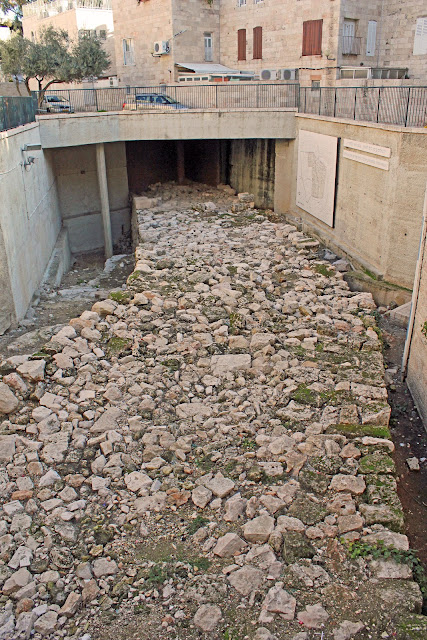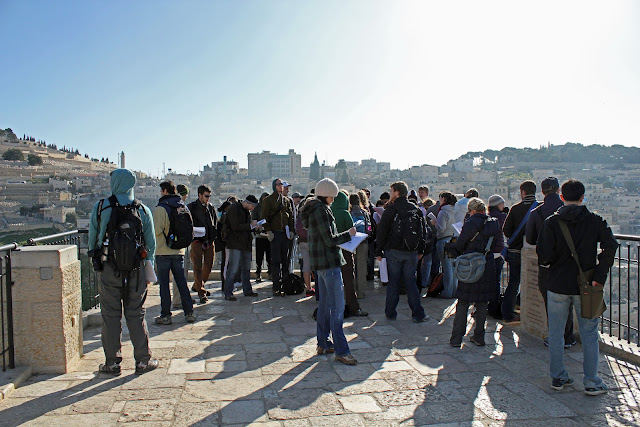Alrighty boys and girls, ready to start class? :)
As I have already mentioned many times, our class went on a walk on Sunday. We walked for about 11 hours and covered several thousands of years of ancient history. When you think of the ancient times, do you believe that structures dating thousands of years are still standing? Do you think that people know where each event in the Bible took place and that many physical evidences of it still stand? For example, "Everyone knows where Golgotha is, the 3 crosses still stand!," "This house right here, this is where Jesus had His last supper with the disciples," "Oh, and this, this is David's tomb, isn't it great?!" In all my naiveness, I believed such things until coming here. The truth: not every Biblical site is yet found.
To be frank, I was slightly disappointed to hear that the city of Jerusalem looks very different today comparing to Jesus' day, and the fact that no one can say 100% where Jesus' tomb is. There are plenty of Biblical events where scholars and natives still don't know where they occurred. For example, where exactly King David's tomb is (we do know that it's somewhere in the City of David). In fact, did you know that many physical remains from the ancient world are covered up by years of fill. Think about it, a war occurs and the town gets leveled (that is fill and evidence of that town), then another town gets built on the same spot, it also is destroyed, so on and so forth. Through many decades and centuries these levels of destruction get added, one on top of the other they build a story of evidences of previous life. Like a sign, these layers say, "we were here." This then is where archeology comes in and starts to open up that book of mystery. One page at a time the layers start telling us about the history, civilization, and life hundreds of years ago. Archeology in the last 40 years has peeled away the earth in order to reveal the ancient times; times of the kings, the prophets, and the Messiah.
Below is what is called "The Broad Wall." This city wall was build by Hezekiah before 710 B.C. and was excavated sometime after 1967. They estimate that the wall would have been 8 meters high and roughly 20 feet wide (The current City Walls are half the width). The wall also looks like it was just filled in with anything and everything. It is thought that this wall was built very fast, wide and tall in order to with stand the attack from the Assyrians, who were on their way.
The next picture is of the City of David. No, not all of it. Just the community on the bottom of the picture and to the right. It's a VERY small community which I was so surprised about! Ever read the Old Testament of King David and think that the city was very large? It wasn't. The population was only around 2,000 people during King David's reign. As our professor said, "If you lived back then, you would probably know King David personally." This is why I wrote my last post (Part I), such a small city but God worked wonders through it! He works through the impossible. Also, when you read Psalm 121:1 "I will lift up my eyes to the hills; from where shall my help come? This was a cry for help! City of David is completely surrounded by hills/mountains all the way around, it was and is very easy to get to and attack. His hope was only on God. One last thing, can you see the roof tops? Understand the whole David and Bethsheba thing? Plus keep in mind that back then it was very normal for people to bathe on their roof tops.
This is our class standing on a roof top over-looking the City of David. Everyone was so happy to soak up the sunshine after being in the shade half the morning.
Left: Not every archaeologist agrees, but some do believe that this was a retaining wall for David's palace. The palace would have stood where that house (info station) now stands. Right: Ancient toilet, perhaps from Joshua's time. Yikes, that's pure, cold, solid, stone.. brrrr.
Hezekiah's tunnel
This site also excavated not long ago. It is the ruins of the temple of the Herodian times.
This would have been a main street during Jesus' time. It is very very very likely that Jesus walked here. The ruins are from the Roman's attack on Jerusalem 70 AD. There would have been shops on the right hand side, see picture below.
As you see, the stones are very large in size. There are some stones so large, the estimated weight of them is 200 tons. (Side note: I take pictures and he takes notes for the both of us. Great team, ei?:))
This is the pinnacle of the temple. They would make announcements for the city here. Also, this is believed to be the place where Jesus was tempted by the devil (luke 4:5).
Mount of olives behind us.
These steps are the temple steps. It is here that rabbi's would teach their students and others would gather round to listen. It is believed that on these steps Jesus spoke to the Pharisees and scribes telling them (Matt 23), you "tie up heavy burdens and lay them on men.." you "love the place of honor at banquets and the chief seats in the synagogues and respectful greetings in the market places..." "you are like whitewashed tombs.." "for you build the tombs of the prophets and adorn the monuments of the righteous..." "how will you escape the sentence of Gehenna?" From these steps you can see all the things that Jesus was talking about in this chapter: white tombs (mount of olives) was to the right, the market place to the left, the temple behind, "gehenna" or the Hinnom Valley straight ahead.
And this is us being taught by our teacher:)
Left: Old (during Jesus' time or earlier) stairs in the front and newer stairs further up. Right: Old stairs towards the bottom of the picture and then newer stairs.
Left: Believed to be the pools of Bethesda (John 5:2-9, 14) Right: St. Anne's Church which is right next to the pools of Bethesda. We (about 30 of us) went into the church and sang a few songs. You would not believe the sound in this place, we sounded like an army of hundreds!
Outside of St. Anne's Church
Beautiful cyprus trees
We ended the day on a roof top of an Armenian Hospice which over looks the Old City.
That gold dome is "the dome of the rock," it's a masque built in the 7th century. It is smothered in real gold. It also stands where the temple of Solomon once stood.
























my favorite post so far!
ReplyDeletei wish i had classes like this when i was in college:) lots of exercise and learning at the same time...and not your usual textbook learning. i'm a little jelly
Anya Ty
I am really glad that you enjoyed it! These weekend trips are indeed very different from the typical classroom and teach you things in a whole new way. Truly thankful to God for this amazing experience. Don't be too jelly, you are young and i am sure that the Lord will provide you with many wonderful experiences in your life:)
ReplyDeleteGood call on tag teaming the journaling/photo taking. The idea of visiting you guys is sounding more and more appealing!
ReplyDeleteps, send me your address.
Tana
Address????! Does this mean we can anticipate some goodies??:) i will message it to you.
ReplyDeleteVadim, don't pee in Hezekiah's tunnel. That's not your tunnel. Its Hezekiah's tunnel.
ReplyDeleteI didn't follow your example this time, don't worry Aleks.
ReplyDeleteNatalya I am SO enjoying your blog! I feel like I am right there beside you looking at these wondrous places because you narrate it so well. Can't wait for more! Also, totally had your thinking about Jerusalem and very interested to learn what "fill" was. It never even crossed my mind!
ReplyDeleteThank you sister! I am enjoying your blog! And the pictures! Love you!
ReplyDelete